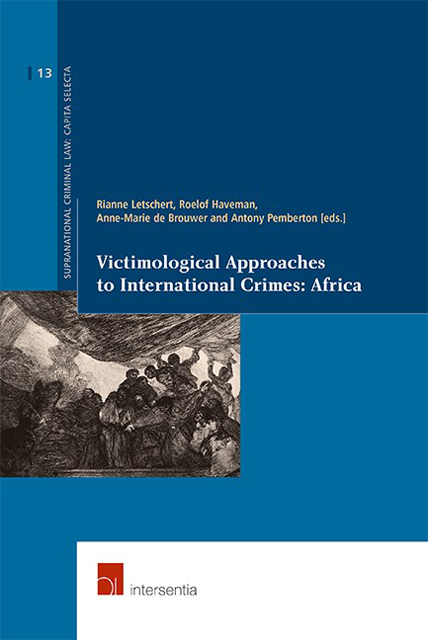Book contents
- Frontmatter
- Words of Appreciation
- Contents
- Introduction: Victimological Approaches to International Crimes
- Part I Victims of International Crimes
- Part II Reparative Justice
- PART III Amnesty, Truth, Reconciliation and Tradition
- Part IV International and National Legal and Policy Approaches
- Part V Victimological Approaches to International Crimes
- The Authors
- Bibliography
XXIII - Victimological Approaches Applied to International Crimes: Concluding Remarks
Published online by Cambridge University Press: 24 November 2022
- Frontmatter
- Words of Appreciation
- Contents
- Introduction: Victimological Approaches to International Crimes
- Part I Victims of International Crimes
- Part II Reparative Justice
- PART III Amnesty, Truth, Reconciliation and Tradition
- Part IV International and National Legal and Policy Approaches
- Part V Victimological Approaches to International Crimes
- The Authors
- Bibliography
Summary
INTRODUCTION
In Rwanda: Death, Despair and Defiance, African Rights (1994) described the horrific cruelties against and killings of Tutsi and moderate Hutu by extremist Hutu over a period of a few months only (see also Ruvebana, this volume). In 1994, the beautiful country of Rwanda – also known as the country of one thousand hills – was engulfed by one of the most eff ective and most public genocides of all time. with in 100 days, from April 7 to July 18, about 800,000 Tutsi and moderate Hutu were brutally murdered by extremist Hutu, including their neighbours, friends and acquaintances. In those 100 days, an estimated 250,000 to 500,000 women and girls, but also men, were raped and experienced other forms of sexual violence. As a 1996 United Nations report observed, “rape was the rule and its absence the exception”. For many survivors, rape and other forms of sexual violence, but also the resulting HIV infection, babies born from rape, and stigmatization and isolation by their family and community members, constitute the ultimate violation of their human rights. In addition, the genocide left hundreds of thousand children orphaned and a similar large number of survivors lost their husband, wife and/or child(ren). Many lost their houses and other possessions. The country's economy, its judicial institutions and social services were completely destroyed. Over 1 million people were involved in the genocide and survivors and perpetrators are now again living side by side. Slowly but withstrong determination, the country is recovering from its horrific past. Programs of reparation and reconciliation, national and local, have been developed, and (tradition-inspired) justice mechanisms put in place.
Many instances of mass atrocities and in many ways similar carnage preceded and followed the period of the Rwandan genocide in different parts of the world.
In the 20th century alone, hundreds of millions fatalities occurred (Rummel 1994), and the scourge of international crimes – genocide, crimes against humanity and war crimes – remains a reality today. Attempting to do justice under the sceptre of such heinous cruelty and unspeakable suffering is a daunting task, withthe enormity of evil blowing up the limits of normally held trials and convictions.
- Type
- Chapter
- Information
- Victimological Approaches to International Crimes: Africa , pp. 621 - 646Publisher: IntersentiaPrint publication year: 2011

